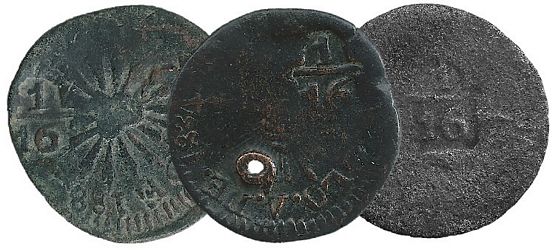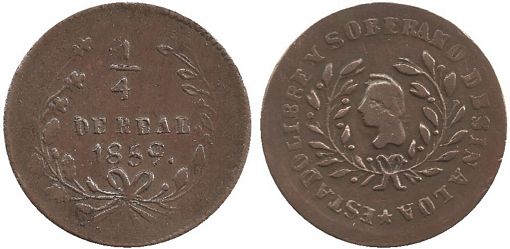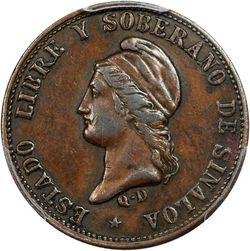Quintín Douglas and Sinaloa cuartillas made at the Hermosillo Mint
by Dr. Guzmán Sánchez-Schmitz
In 1857, a new Mexican Constitution ignited a bloody nation-wide confrontation between Conservatives and Liberals. That year, acting as provisional Governor of Sonora, Ignacio Pesqueira defeated the rebels, thwarted Henry A. Crabb’s filibustering expedition into Sonora and won the governorship elections. By 23 March 1858, the new liberal congress of Sonora — lead by a young mine engineer named Manuel Monteverde — recognized the legality of the new Constitution and empowered Pesqueira to dispose of all federal taxes paid at the port of Guaymas to cover the expenses of the war against the dissenters and the rebel indians. Urged to intervene in the affairs of Sonora’s sister state, Pesqueira sent men, arms and supplies to Sinaloa in 1859, besieging the port of Mazatlán and ultimately assuming its provisional governorship. Conservative leaders Manuel Gándara, Pedro Espejo and José María Yañez — who were in control of Sinaloa at the time — managed to escape onboard a captured British frigate Rudolph F. Acuña, "Ignacio Pesqueira: Sonoran Caudillo" in Journal of the Southwest, Arizona and the West, Vol. 12, No. 2 (Summer, 1970), pp. 139-172. Although Pesqueira had secured a special Presidential authorization to strike copper since 1857, Sonora had no mint to coin it: the mint of Concepción de Alamos had operated briefly between 1828 and 1829 — when Sonora and Sinaloa formed the conjoined State of Occidente — and the mint of Hermosillo certainly struck coins between 1832 and 1836 (and probably also in 1839Mike Dunigan and J.B. Parker. Resplandores. Cap and Rays 8 Reales of the Republic of México 1823-1897. Superior Stamp & Coin. Beverly Hills. 1997). At last, in 1859 the opportunity arrived at Mazatlán where — in representation of the now “free and sovereign state of Sonora and the provisional of Sinaloa” — Pesqueira arranged the coining of Sonora’s copper at the mint in Culiacán on 5 May 1859Alberto Francisco Pradeau, Historia Numismática de México de 1823 a 1950. Tomo Segundo. Cecas de: Hermosillo, Alamos, Catorce, Chihuahua, Culiacán y Durango. Sociedad Numismática de México, México, 1960; Alberto Francisco Pradeau, Sonora y sus Casas de Moneda, Alamos y Hermosillo. Gobierno del Estado de Sonora. Hermosillo, 1983.. The new copper coinage was justified by the urgency to substitute the old circulating copper money, “improper and imperfect in its type, execution and weight and also false to a great extent”. The old Sonora copper coinage still circulating in 1859 — more than two decades after the Government officially stopped their manufacture (and the Hermosillo mint closed) — was the so-called “Santoyo Cuartillas” [1832-1836, KM364], running in all kind of shapes and conditions but bearing or attempting to bear a year date no higher than the year 1836 — the last year considered official. These cuartillas were also known as “Gándara Cuartillas” because it was Governor Gándara who ordered a devaluation countermark to “1/16” of a real on 23 July 1837, and also a perforation to signify their demonetizationibid..

Leonardo Santoyo (L.S.) cuartillas devaluated by Gándara to 1/16th of a real
To earn public confidence, the new Pesqueira coinage was to be “unfalsifiable” based on the “good old times concept” of intrinsic value — appreciation and trust based on metal, craftsmanship and weight. He ordered 50,000 pesos for the State of Sonora, two-thirds in cuartillas (¼th of a real) and one third in octavos (⅛th of a real). A pound of copper (460 grams (gr)Ignacio Carrión Arregui, Los antiguos pesos y medidas Guipuzcoanos. Universidad del País Vasco, 1996. was to produce 32 Sonora cuartillas (theoretically weighting half an ounce/each, 14.375gr), or 64 Sonora octavos of 7.188gr/each, both corresponding to a nominal face value of 8 reales or one “peso fuerte”. Thus, the order was for 1,066,666 cuartillas (33,333 pesos) and 1,066,666 octavos (16,666 pesos).
Besides coinage for Sonora, Pesqueira ordered the striking of 5,000 pesos in cuartillas for the District of Culiacán, with identical design and weight as those already circulating there in 1859. Accordingly, we know today of Sinaloa cuartillas dating 1859, with the same design and weight as the preceding cuartillas.

KM 363 ¼ real 1859 Sinaloa
The first issue of Sinaloa cuartillas was ordered on 2 March 1847 (30,000 pesos or 960,000 cuartillas)Pradeau, op. cit. and includes the years 1847 and 1848. Thus Pesqueira’s order should be considered its second issue, starting in 1859 and followed by the years 1861, 1862, 1863, 1864, 1865 and 1866. Their general design shows on one side a small head of Lady Liberty, facing left, wearing the Phrygian cap (in obvious imitation of L. Rovira’s Liberty head present on contemporaneous Federal silver cuartillas (1842-1863, KM 368.6). This small head is located in the center within two olive branches tied up with a ribbon, the whole surrounded by the legend “ESTADO LIBRE Y SOBERANO DE SINALOA” (THE FREE AND SOVEREIGN STATE OF SINALOA), and ending with a five-point star. The other side shows at center in three lines: 1/4 — followed by — “DE REAL” — ending with the date (that in most cases has a dot after it); all enclosed by a branch of olive on the right and a branch of Encino oak on the left, tied up with a ribbon at the bottom. Many catalogs and books refer to Sinaloa cuartillas as weighting 7gr with a module of 27mm and reeded edgePradeau, op. cit.; T. V. Buttrey and Clyde Hubbard, A guide book of Mexican Coins. 1822 to date. 2nd edition, 1971; Editor David C. Harper and market analysts Richard Giedroyc & Thomas Michael, North American Coins & Prices, 26th edition. Krause Publications, 2017.; Don Bailey. State & federal copper and brass coinage of México, 1824-1872. Don Bailey Institute for Mexican Numismatic & Historical Research, 2008; Dr. Geo. W. Vogt. Standard Catalog of Mexican Coins, Paper Money and Medals. Krause publications, 1978.; however, surviving specimens of Sinaloa copper cuartillas today rarely match these numbers. The average diameter and weight from about 57 specimens in my collection is 26.4mm and 6.2gr, respectively. None of the copper coinage ordered by Pesqueira in 1859 from the mint of Culiacán included its mintmark, just the name of the state that sanctioned its legality and circulation.
Quintín Douglas was a Scottish immigrant who settled in Sinaloa, worked at the Culiacán mint (then under Jecker, Torre & Co), bought a big ranch close to the famous silver/money-smuggling port of Altata, re-opened the mints of Hermosillo and Alamos in Sonora and married Miss Paula Salmón. However, the thing that makes our engineer and entrepreneur Quintín Douglas very special to our story is not that he moved to Hermosillo in 1860 and managed to re-open the mints of Hermosillo and Alamos, but that he created the following copper Sinaloa cuartilla pattern dating 1861, bearing his initials Q.D under the liberty head.


KM Pn82 Sinaloa Pattern ¼r 1861 (Stack’s Bowers Baltimore auction, 16 November 2012, lot 11283)
It seems Pradeau was the first person to suggest that the letters Q.D. could refer to Quintín DouglasPradeau, op. cit.. Thanks to some documents, kindly facilitated by Stanford University, I can now confirm this presumption, that Douglas did indeed produce a copper pattern for Sinaloa in 1861. The following letter is dated on 21 May 1861 and was written by Douglas when he was visiting his family at Culiacán and addressed to the Governor of Sinaloa (Plácido de la Vega DazaPlácido de la Vega Daza was a direct descendant of Holy Roman Emperor Charlemagne and a 13th generation descendant of Christopher Columbus. His family had been granted vast tracts of land and gold and silver mines and held major political and commercial influence in Northern Mexico. However, Plácido himself managed to grow up liberal, and was an early and strong supporter of both the Reform Constitution of 1857 and of Benito Juárez. On 19 August 1858 he proclaimed “El Plan de El Fuerte” in favor of the liberal Constitution, and became governor of Sinaloa on 4 June 1859, serving until 1862.
When the French blockaded Mazatlán in March 1864 de la Vega, with his volunteer Central Army 3rd Division, organised its defence. However, in mid 1864 Juárez sent de la Vega to the United States on a secret mission to seek support – and raise funds for – his cause. Divisions between the remaining Juaristas led to Mazatlán being taken by the French) residing in Concordia (a town near the port of Mazatlán):
Answered 12 June 1861 at Concordia. Culiacan, May 21/861. / Sir Mr. Placido Vega Mazatlan / My dear Sir: With this mail envoy I remit to you several coins of those that are being produced by the mint that I have established in Hermosillo: also included is a coin of the type I opened for the copper coinage of this State so in case you like it, and wish to adopt it, you would dispose what you see best. Since very soon I will have the pleasure of seeing you I conclude the letter reiterating that I am your most attentive friend and S.S. (“Secured Servant”)/ Quintín Douglas … Mr. Romero (addendum by Mr. Mariano Romero): Mr. Douglas remitted several coins of those that are being produced by the mint he established in Hermosillo; also he included a coin of the type he opened for the copper coinage of this State, so in case you like it, and wish to adopt it, you may dispose of it. … (answer by governor Plácido Vega) … I reply here to your letter of the 21st of the past month that I have the pleasure to opportunely receive. There arrived in my hands those coins of the appreciable State that you served the merit of mentioning in the first paragraph as well as the coin of the type for the copper coinage of this State; all this so you are aware, sincerely Stanford University Libraries; Guide to the Plácido Vega papers, 1855-1864; Online Archive of California. Stanford University ].
The additions by Mr. Mariano Romero and Governor Plácido Vega, both in different handwriting, confirm the information and reception of the pattern and coins produced by Douglas in Hermosillo.
Were these Sinaloa cuartillas ever produced at the Hermosillo mint? The following trail of personal communications between Douglas and the governor of Sinaloa after 21 May 1861 confirms there was a coining of more than half a million Sinaloa Cuartillas at the Hermosillo mint before February 1862:
1. Q. Douglas (in Hermosillo) to the Governor of Sinaloa (in Alamos):
Hermosillo 5 November /861. / Sir Mr. Placido Vega, Alamos / My appreciated friend. … Speaking about our mint situated on this city (Hermosillo): Mr. Ramón Feliz and Buelna could provide to you a detailed account of its system; because this gentleman had seen in great detail all its mechanism. With respect to the coining of copper that I have to strike for your state of Sinaloa, as copper in this state is extremely scarce, it is precisely and absolutely necessary that you remit to me all the copper in the possession of Mr. Canuto Ybarra; or in its defect, at least 300 quintales. I already have
made all the dies, punches and all other means needed. … / Quintín Douglasibid..
2. The Governor of Sinaloa (in Mazatlán) to Quintín Douglas (in Hermosillo):
Port of Mazatn. 12 January 1862. Sir Mr. Quintín Douglas. My dear friend. …;… You may know already of a decree given by the State Congress prohibiting the striking of the copper coinage that was under production at Culiacán; and despite my efforts to get its authorization, I consider to be convenient that you suspend this business (the coining of Sinaloa Cuartillas at Hermosillo) for now. …as always your fine friend and S. S. ibid.
3. Quintín Douglas (in Hermosillo) to the Governor of Sinaloa:
Hermosillo 1 February 1862. Sir Mr. Plácido Vega. My appreciable friend, … According to your letter, I will immediately suspend the striking of the copper coinage that is destined to circulate in the State under your respectful command; however, I had already coined about eighteen thousand pesos. (~576,000 Sinaloa Cuartillas) ... / Quintín Douglas. ibid.
4. The Governor of Sinaloa (in Mazatlán) to Quintín Douglas (in Hermosillo):
Mazatlan 11 April 1862 / Sir Mr. Quintín Douglas / Hermosillo / answering your appreciable letters dated 1 and 24 February that because of my occupations I put aside until today – I must tell you that I acknowledge that you did suspend the coining of (gun powder) copper of which you had already made eighteen thousand pesos. I strongly ask that you keep this amount in rigorous deposit, because I have addressed to the General Government a request for an authorization to coin copper; as soon as I receive it, which I do not doubt will be very soon, we will release your coinage for circulation. … your fine and S. S. Q.B.S.M. footnote}ibid.. Here, there was a mistake in the letter (indicated in the parenthesis).
5. The Governor of Sinaloa (in Mazatlán) to Quintín Douglas (in Hermosillo):
Mazatlan 31 August 1862 = Sir Mr. Quintín Douglas= Hermosillo = My fine friend and Sir = …I will await that you let me know if you still have in existence the copper that you had coined for this State and that I asked you to preserve intact in order to be used in circumstances such as the one now present: with the activity that you treat this business will depend the making or not of a great service to the Government of Sinaloaibid..
These letters indicate that Douglas made not just the pattern at the Hermosillo mint but “about 18,000 pesos” in Sinaloa cuartillas (~576,000 Sinaloa Cuartillas) between 12 December 1861 and 1 February 1862. Considering the time-span and:
that the agreement between Plácido and Douglas to make Sinaloa cuartillas in Sonora occurred in 1861;
that the cuartilla pattern had the date 1861;
that the dies should have been made at the Hermosillo mint between 21 May 1861 and 5 November 1861;
that it would had taken less than three weeks to coin Plácido’s copper in Hermosillo after 19 November 1861;
that there was an urgent need for resources to pay soldiers and buy the expensive war equipment being procured in 1861; and
that Sinaloa cuartillas were also produced at the Culiacán mint in the same year of 1861;
it is likely these Sinaloa cuartillas produced at Hermosillo Mint also carried the year 1861, specially to help them blend in with those cuartillas already being produced at Culiacán that same year.
